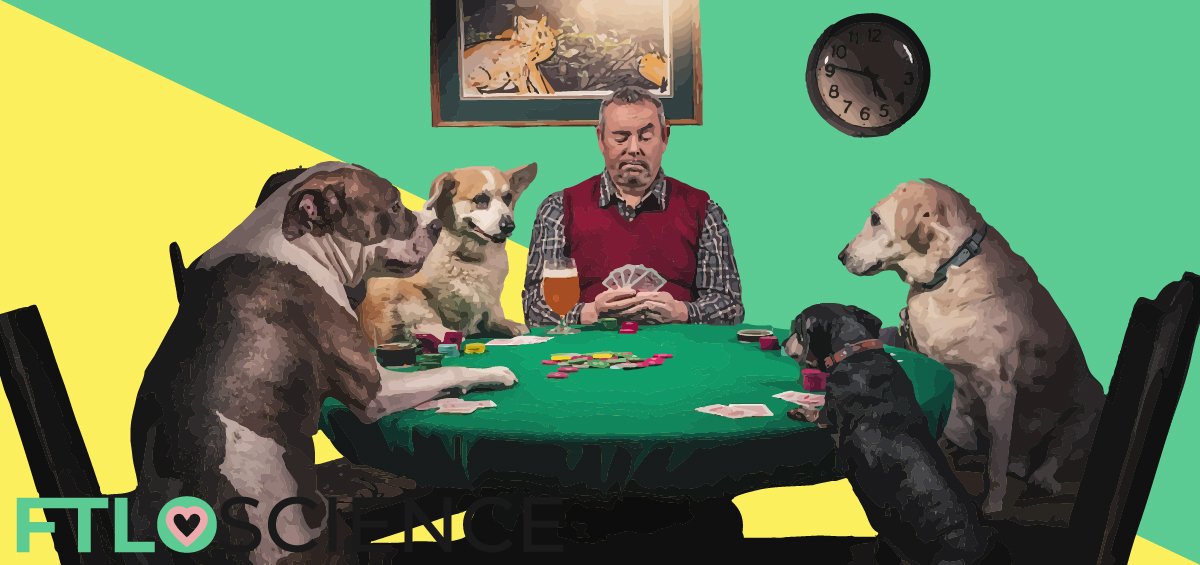Dogs Playing Poker is a series of famous oil paintings depicting anthropomorphic dogs seated around a table playing poker. While nobody really expects their dog to have its canine buddies over for a card game, just how far removed is this scenario from reality? We take a frivolous look at what the science says about a dog’s intelligence in the context of poker mathematics and psychology.
Assessing their ability to do math and ‘read’ tells, we can safely say that dogs cannot play poker. Dogs cannot reliably count, although they can tell the difference between two sets of numbers. Dogs can assess emotions too, with a focus on the ears, although they also find it difficult to conceal their feelings, giving away tells.
Assessing How Well Dogs Count
Visual Addition
If a dog is to play poker, it must be assessed on its ability to do the math. A rudimentary understanding of probability and value is key to any poker strategy. Alright, so it might be a stretch to ask dogs to assign a relative value to each hand. But can we expect them to know the value of each card? Or at the very least, count the number of cards they have in their hands (or rather, paws)?
A study in 2013 put the the counting ability of dogs to the test. 27 dogs were shown two identical food bowls, after which a different number of treats (between 1 to 4) were dropped one at a time into them. Without looking at the contents of the bowls, the dogs could then choose one to eat out of. Ideally, they would go for the one with more treats dropped inside.

But the dogs in the study couldn’t really differentiate between the other numbers. When different numbers of treats were dropped into the bowls, the dogs could really only differentiate reliably between 1 and 0 (food vs no food).
Overall, their ability to choose the bowl with a higher number of treats was only slightly better than pure chance.
However, they could tell between the 1 and 0 conditions 100% of the time, so it showed that they can tell when no treats are in a bowl. It’s unfortunate that dogs playing poker will never encounter such a scenario.
Ability to Compare Numbers
But what about the ability to assign value to a number? After all, standard playing cards have a number of shapes that depict their value (excluding face cards). To determine this value-assigning ability, a dog was given two boxes with several shapes on the front, with the higher value box containing treats. The number of shapes on the box could vary between 0 and 9.
After 720 trials over several weeks, the result was one tired dog. Also, the dog was shown to be able to differentiate well when the difference between the number of shapes was large (i.e., 1 vs. 9, or 0.11 ratio). It performed significantly above chance even for more difficult ratios (0.75, 3 vs. 4), although this ability worsened considerably with the most challenging ratio (0.89, 8 vs. 9).

Theoretically, an intelligent dog would be able to judge the value of a card based on the number of shapes on it. A dog playing Texas hold ’em poker could tell the difference in their hole cards. Although once the flop is shown, they might have some trouble comparing more than two cards.
Soft Poker Skills in Dogs
Dogs Have Great ‘Reading’ Ability…
Math aside, soft skills also play a big part in poker. Oftentimes, poker players will represent a weak hand as a strong one or vice versa. Poker involves being able to ‘read’ your opponent’s emotions or expressions to gain some information about their hand. Conversely, covering up your own ‘tells’ is equally important to prevent opponents from gaining an advantage.
In poker, your face is most likely to betray you. Your eyes might light up if you have a strong hard, or your lips might twitch a little when you’re trying to steal the pot with a bluff. Luckily for dogs, they are quick and adept at processing facial expressions.
A study of 31 dogs showed that their initial gaze on faces shifts from the eyes, ears, midface and mouth last. When shown different facial expressions (both human and dog), they were quick to distinguish between threatening, pleasant and neutral.
Interestingly, they were observed to fixate on the eyes of threatening dogs but avoided looking at the threatening human faces altogether. An evolutionary consequence of domestication by humans, perhaps?
In terms of assessing emotions, dogs might be even better than humans! Tracking of a dogs’ gaze showed that they paid more attention to the ears and mouth. These regions in dogs have been found to be used to express happiness, anticipation and fear. In humans, our ears don’t (or rather, can’t) express much emotion, but this isn’t the case for our canine counterparts.
… But Give Away Too Many Tells
It’s a big advantage to be able to read opponents at a poker table. Unfortunately for dogs, the opposite is also true. Dogs are honest creatures that find it hard to cover up their feelings.
Studies show that dogs consistently display certain facial expressions as a reaction to emotions. Using computational tools, emotions of stress, discomfort and fear in dogs were associated with the contraction of distinct facial muscles.
The study also found that while the basic facial muscles of dogs resembled those of humans, their expressions of these do not mirror the same emotions in humans. For example, dogs sometimes squint to protect their eyes, but this can be mistaken for anger or disgust. So, if you ever do get into a game of poker with a dog, make sure you don’t overread its tells!
From a poker point of view though, there really isn’t a need to worry about them giving away too much. Dogs playing poker probably won’t even notice that they have been dealt the best hand, let alone if they’ve made a royal flush.
Dogs Playing Poker in the Future?
If there’s one thing that a dog is great at, it’s reading people (and other dogs). Dogs can assess emotion in faces extremely quickly, paying attention to a variety of facial cues. However, they are also known to express their emotions consistently and freely. That’s probably why they make such great companions and are even used as therapy animals.
However, their mathematical skills (or lack thereof) are holding their poker careers back. Although able to distinguish between more and less, dogs are not so good at counting. Dogs have been bred for a whole range of purposes; hunting, herding, protection or simple companionship. Counting? Probably not.
So yes, while a dog might be able to take a seat at the poker table (on command, no less), it probably wouldn’t be wise to stake its buy-in.
Perhaps in the future, a mathematically gifted breed will make ‘dogs playing poker’ a reality. But even then, it might be too much to ask a dog to hold playing cards in its clumsy paws.
About the Author

Sean is a consultant for clients in the pharmaceutical industry and is an associate lecturer at La Trobe University, where unfortunate undergrads are subject to his ramblings on chemistry and pharmacology.




